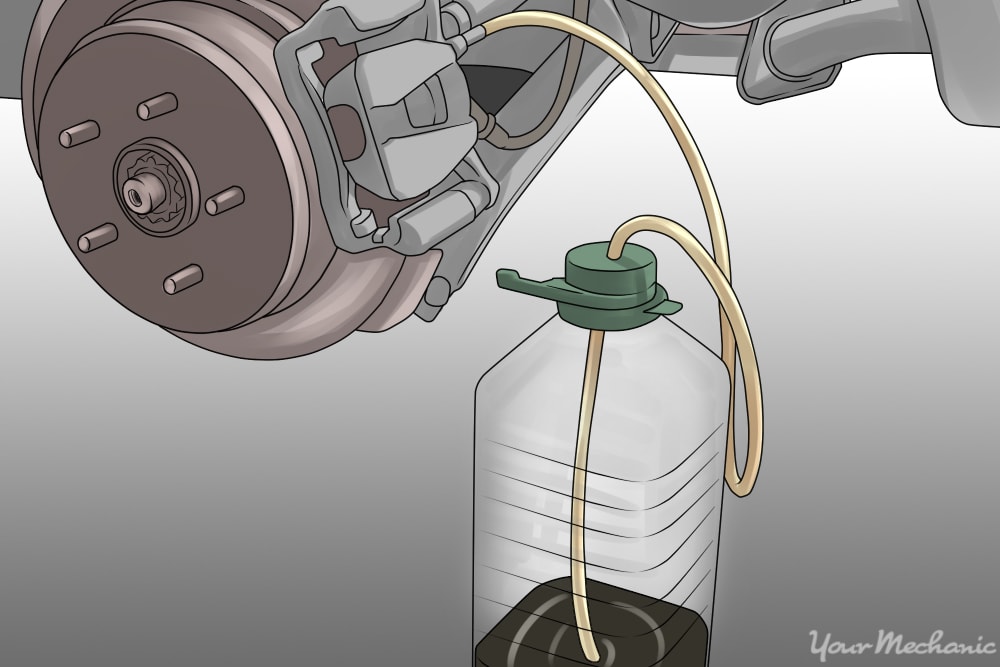How to Change Brake Fluid Without Bleeding
To change brake fluid without bleeding, use a vacuum pump to extract old fluid, then refill with new fluid. Avoid air entering the system.
Brake fluid is a crucial component in a vehicle’s braking system, ensuring optimal performance and safety. By regularly changing brake fluid, you can maintain the efficiency of your brakes and prevent brake failure. While the traditional method of bleeding brakes can be time-consuming and challenging, there is an alternative approach to changing brake fluid without the need for bleeding.
We will explore how to effectively replace brake fluid without the hassle of bleeding, providing a step-by-step guide for DIY enthusiasts and car owners looking to maintain their vehicle’s braking system.

Credit: www.motortrend.com
Importance Of Brake Fluid
Importance of Brake Fluid: Brake fluid is a critical component of your vehicle’s braking system. It plays a crucial role in transferring force from the master cylinder to the wheel cylinders or calipers, allowing your car to slow down or stop effectively. Maintaining clean and proper brake fluid is essential for ensuring optimal braking performance and overall safety on the road.
What Is Brake Fluid?
Brake fluid is a specially formulated hydraulic fluid that transfers the pressure created when you press the brake pedal to the brakes themselves. It is typically glycol-ether-based or silicone-based, and it operates at high temperatures, making it essential for the safe and efficient operation of your vehicle’s braking system.
Why Is Brake Fluid Important For Braking Performance?
- Transfers pressure: Brake fluid transfers the force from the brake pedal to the brakes, allowing for effective deceleration and stopping.
- Prevents corrosion: It protects metal components of the braking system from corrosion and deterioration.
- Heat resistance: Brake fluid operates at high temperatures without boiling, ensuring consistent braking performance.
- Seal lubrication: It provides lubrication for the seals in the braking system, preventing leaks and maintaining integrity.
Signs Of Contaminated Or Old Brake Fluid
- Discoloration: Brake fluid may appear darker or have a cloudy appearance if it’s contaminated or old.
- Soft brake pedal: Contaminated brake fluid can cause a spongy or soft brake pedal, indicating air or moisture in the system.
- Increased stopping distance: If you notice a longer distance required to stop, it could be a sign of degraded brake fluid affecting braking performance.

Credit: www.yourmechanic.com
Preparing For Brake Fluid Change
Changing brake fluid without bleeding can be a daunting task, but with these expert tips, you can streamline the process. From choosing the right tools to following step-by-step instructions, you’ll be prepared to tackle this crucial maintenance task efficiently and effectively.
Gathering The Necessary Tools And Materials
Ensure you have a brake fluid tester, new brake fluid, a turkey baster, and a clean container.
Ensuring A Safe And Well-ventilated Work Area
Choose a flat, stable surface with good lighting and adequate ventilation for safety.
Taking Safety Precautions
Wear protective gloves and goggles to prevent exposure to brake fluid. Avoid contact with skin and eyes.
Step-by-step Guide To Changing Brake Fluid
Learn how to change brake fluid without the need for bleeding. This step-by-step guide provides clear instructions for the process, ensuring that your brake system remains air-free and fully functional. By following these detailed steps, you can ensure a smooth and safe brake fluid replacement without the hassle of bleeding.
Lift The Car And Remove The Wheels
Use a car jack to raise the vehicle off the ground safely.
Locating The Brake Fluid Reservoir
Find the brake fluid reservoir usually located near the engine.
Draining The Old Brake Fluid
Use a syringe or turkey baster to remove the old brake fluid.
Refilling With Fresh Brake Fluid
Slowly pour fresh brake fluid into the reservoir to the proper level.
Testing The Brake Pedal
Pump the brake pedal to ensure proper pressure and performance.
Alternative Method To Bleeding Brake System
When changing brake fluid without bleeding the system, using a vacuum pump to remove the old brake fluid is an effective alternative method. This process allows for the thorough removal of old fluid without the need to bleed the entire brake system, making it an efficient option for DIY enthusiasts.
Using A Vacuum Pump To Remove Old Brake Fluid
A vacuum pump is a handy tool for this alternative method. By attaching the pump to the brake fluid reservoir, it creates a vacuum that draws out the old brake fluid. This method is less labor-intensive compared to bleeding, as it doesn’t require opening and closing of the bleeder valves. The vacuum pump helps in extracting the old fluid swiftly and efficiently.
Refilling Brake Fluid Without Introducing Air Bubbles
When using this alternative method, it’s essential to maintain a steady vacuum while refilling the brake fluid. Keeping the reservoir topped up throughout the process minimizes the risk of air bubbles entering the system. This helps ensure that the brake system remains free of contaminants and operates smoothly.
Benefits And Limitations Of Using A Vacuum Pump
Using a vacuum pump for changing brake fluid offers the advantage of precision and control in fluid removal and refilling. It’s also a suitable method for individuals who may not have assistance for traditional bleeding. However, it’s important to note that using a vacuum pump may not be suitable for purging air bubbles from the brake system if they are present.
Routine Brake Fluid Maintenance
Proper brake fluid maintenance is crucial for the safety and performance of your vehicle. Regularly changing the brake fluid and monitoring its level and condition not only extends the life of your braking system but also ensures your vehicle is operating safely on the road. In this blog post, we will discuss the recommended intervals for changing the brake fluid, how to check the fluid level and condition, and common mistakes to avoid.
Recommended Brake Fluid Change Intervals
Changing the brake fluid at the right intervals is essential to prevent brake failure and maintain optimal braking performance. It is generally recommended to change the brake fluid every two years or every 30,000 miles, whichever comes first. However, it’s important to consult your vehicle’s manufacturer manual for specific recommendations, as intervals may vary depending on the make and model.
Checking Brake Fluid Level And Condition
Regularly checking the brake fluid level and condition is a crucial part of routine maintenance. Here’s how to perform this important task:
- Park your vehicle on a level surface and ensure the engine is cool.
- Locate the brake fluid reservoir, typically found near the master cylinder under the hood.
- Remove the cap from the reservoir and inspect the fluid level. The fluid level should be between the “minimum” and “maximum” markings on the reservoir.
- Examine the condition of the brake fluid. It should be clear or slightly yellowish in color. If the fluid appears dark, dirty, or contaminated, it may be time for a fluid change.
- If the fluid level is low, carefully add the recommended brake fluid until it reaches the appropriate level. Be sure to use the type of brake fluid recommended by your vehicle’s manufacturer, which is typically DOT 3 or DOT 4.
- After verifying the fluid level and condition, securely replace the cap on the reservoir.
Common Mistakes To Avoid
When it comes to brake fluid maintenance, it’s important to avoid common mistakes that can lead to brake system problems. Here are some mistakes to avoid:
- Neglecting to change the brake fluid according to the recommended intervals, putting the braking system at risk of failure.
- Adding the wrong type of brake fluid, which can damage the braking system and compromise performance.
- Using an open container of brake fluid that has been sitting for a long time, as brake fluid can absorb moisture from the air, leading to reduced effectiveness.
- Not properly securing the reservoir cap, which can allow contaminants to enter the brake fluid and compromise its performance.
- Allowing brake fluid to come into contact with painted surfaces or plastic parts, as it can cause damage.
By following the recommended brake fluid change intervals, regularly checking the fluid level and condition, and avoiding common mistakes, you can ensure your vehicle’s braking system performs optimally, providing you with peace of mind and safe travels on the road.

Credit: www.brakebleeder.com
Frequently Asked Questions On How To Change Brake Fluid Without Bleeding
Can I Change My Brake Fluid Without Bleeding?
No, brake fluid change requires bleeding to remove air bubbles for proper function.
Do You Need To Bleed Brakes When Changing Fluid?
Yes, bleeding brakes is crucial when changing fluid to remove air bubbles and ensure proper brake function.
Can I Just Replace Brake Fluid In Reservoir?
No, it’s not advisable to only replace brake fluid in the reservoir. It’s essential to bleed the entire brake system to ensure optimal performance and safety. Always consult a professional mechanic for complete brake fluid maintenance.
Can You Mix Old And New Brake Fluid?
Yes, it’s best to avoid mixing old and new brake fluid. Mixing can contaminate the new fluid and compromise its effectiveness. Brake fluid should be replaced entirely to ensure optimal performance and safety.
Can I Change Brake Fluid Without Bleeding The System?
Yes, it is possible to change brake fluid without bleeding the system by using a specialized tool called a “brake fluid flusher”.
What Happens If I Don’t Change My Brake Fluid?
If you don’t change your brake fluid regularly, it can lead to reduced braking performance, overheating of the brakes, and potential brake failure.
How Often Should I Change My Brake Fluid?
It is recommended to change your brake fluid every 2 years or 20,000 miles, whichever comes first, to maintain optimal braking performance.
Conclusion
Changing brake fluid without bleeding is a manageable task that can be done at home with the right tools and techniques. By following the steps outlined in this guide, you can effectively maintain your vehicle’s braking system and ensure safety on the road.
With regular maintenance like this, you can extend the life of your vehicle and save on potential repair costs in the long run.

